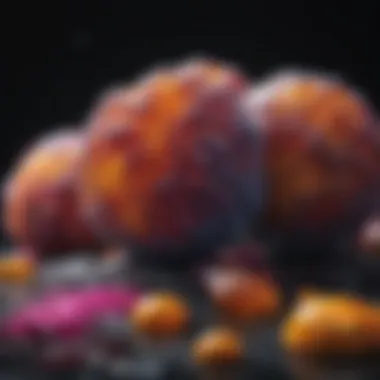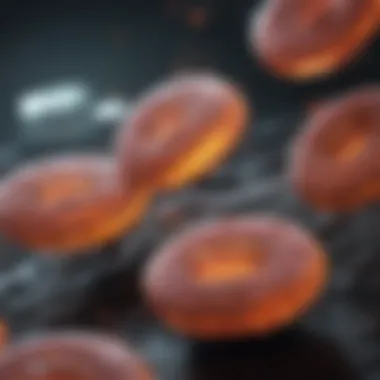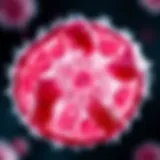Exploring Mitochondrial Potential Dyes in Research


Intro
Mitochondrial potential dyes have emerged as critical tools in the landscape of cellular biology. They offer a window into the inner workings of cells, specifically focusing on the mitochondria, often referred to as the powerhouses of the cell. Understanding how these dyes function, their varied applications, and the implications for future research is essential, especially for students, researchers, educators, and professionals in the biological sciences.
The potential of these dyes extends beyond mere academic pursuit; it intersects significantly with therapeutic development. As the world grapples with increasing metabolic diseases, cancer, and neurodegenerative disorders, the ability to assess cellular health through mitochondrial status becomes paramount. This article endeavors to unpack these topics in detail, providing a comprehensive guide on mitochondrial potential dyes.
Research Overview
Summary of Key Findings
Mitochondrial potential dyes, such as JC-1, Rhodamine 123, and TMRM, play a seminal role in evaluating mitochondrial membrane potential, critical for determining the health and viability of cells.
- Cell health assessment: By utilizing these dyes, researchers can pinpoint changes in mitochondrial function, which correlate closely with cellular activity.
- Dye specificity: Different dyes exhibit characteristic behaviors in response to mitochondrial states, enabling nuanced analyses of various cellular conditions.
- Broad applications: These dyes find utility in numerous fields, including cancer research, aging studies, and pharmacological assessments.
Background and Context
Mitochondria are integral to cellular respiration and energy production. Over the years, the study of mitochondrial dysfunction has gained prominence due to its implications in numerous pathologies. Researchers have devised various methods to visualize and quantify mitochondrial potential, among which the use of specific dyes has proven effective. As the role of mitochondria expands in the context of metabolic regulation and apoptosis, understanding these dyes’ mechanics and applications becomes increasingly critical.
Methodology
Experimental Design
When designing experiments involving mitochondrial potential dyes, careful selection of the dye based on the specific cellular context is crucial. Here’s an overview of commonly used mitochondrial dyes:
- JC-1: This dye aggregates in healthy mitochondria and emits red fluorescence; in depolarized mitochondria, it remains in a monomeric form emitting green fluorescence.
- Rhodamine 123: A cationic dye that accumulates in active mitochondria but becomes less effective as membrane potential diminishes.
- TMRM (Tetramethylrhodamine methyl ester): Similar to Rhodamine 123 but has a higher stability and can give insights into the dynamics of mitochondrial potential changes over time.
Data Collection Techniques
Data collection often involves fluorescence microscopy and flow cytometry to measure changes in fluorescence intensity, which corresponds to changes in mitochondrial membrane potential.
- Fluorescence microscopy: Allows visualization of mitochondrial distribution and health at a cellular level.
- Flow cytometry: Offers quantitative data on larger cell populations, facilitating statistical analyses.
"The insights derived from mitochondrial potential dyes not only enhance our understanding of basic cellular processes but also open pathways for therapeutic innovation."
In summary, assessing mitochondrial health through specific dyes provides a robust framework for a variety of biological inquiries, paving the way for future research and therapeutic opportunities.
Foundational Concepts of Mitochondria
Mitochondria are often regarded as the powerhouses of the cell, and for good reason. They are crucial for generating adenosine triphosphate (ATP), which is an energy currency for various cellular processes. Understanding the fundamental role of these organelles is critical, especially when discussing mitochondrial potential dyes, as these dyes are directly related to the function and health of mitochondria. The health of cells, as well as their ability to respond to stress and stimuli, hinges on the performance of mitochondria.
With cellular metabolism heavily relying on these organelles, their functionality affects a range of important biological processes. Without mitochondria, the basics of energy production would be compromised, leading to inefficiency in cellular functions. The study of mitochondria has grown in prominence, especially in relation to various diseases, where the malfunctioning of these organelles can contribute significantly to pathophysiological conditions.
In the context of this article, getting comfortable with the foundational concepts surrounding mitochondria lays the groundwork for a deeper examination of mitochondrial potential dyes. These dyes come into play by providing critical insights into mitochondrial behavior, especially in responses from the membrane potential variations.
Role of Mitochondria in Cellular Metabolism
Mitochondria are not just mere organelles; they perform several vital roles that extend far beyond energy production. First off, they facilitate the Krebs cycle, crucial for fueling the cell with energy. This metabolic pathway generates electron carriers that feed into the electron transport chain, where the magic of ATP production happens. Furthermore, mitochondria also play a part in the regulation of metabolic pathways, such as those involved in lipid and carbohydrate metabolism. This multifaceted participation underscores why mitochondrial health directly correlates with an organism’s overall health.
Without proper guidance from mitochondria, cells can find themselves in a bit of a pickle, unable to maintain energy homeostasis or adequately respond to stress. Conditions like obesity, diabetes, and even some types of cancer can be traced back to mitochondrial dysfunction, magnifying the need to further explore the implications surrounding these organelles.
Importance of Mitochondrial Membrane Potential
At the heart of mitochondrial function lies the mitochondrial membrane potential (ΔΨm). This potential is essential for ATP synthesis; basically, it’s the driving force that helps in the conversion of ADP to ATP.
The concept of electrical potential across the membrane indicates the working condition of the mitochondria. A higher membrane potential indicates healthy organelles that are primed for energy production; conversely, a diminished membrane potential often signals distress or damage. In short, the mitochondrial membrane potential acts like both a sentinel and a signaler, alerting researchers to the health status of these organelles.
"Monitoring the mitochondrial membrane potential is crucial for assessing cellular energy states and identifying cellular dysfunction."
In practical terms, when scientists or medical professionals utilize mitochondrial potential dyes, they're observing changes related to this membrane potential. Variations in ΔΨm can hint at the state of metabolic processes, indicating whether the mitochondria are thriving or merely surviving. In essence, if one wants to grasp the complete picture of mitochondrial dynamics, understanding the nuances of membrane potential is a non-negotiable.


All of these foundational concepts build a framework for appreciating the nuances of mitochondrial potential dyes, driving forward a mix of biochemistry and technology. The intricate dance of energy production, regulation, and signal transduction makes mitochondria an essential focus in cell biology.
Preface to Mitochondrial Potential Dyes
Mitochondrial potential dyes have emerged as vital tools in the realm of cellular biology, particularly for those examining mitochondrial function and cellular metabolism. The significance of these dyes lies not only in their ability to visualize and assess the state of mitochondria but also in the profound implications such insights can hold in diagnostics and research. Understanding mitochondrial potential dyes entails recognizing their mechanisms, uses, and the broader context in which they function.
When it comes to cellular health, the condition of mitochondria plays a crucial role. Mitochondria are often referred to as the "powerhouses of the cell," underscoring how they generate energy through ATP production while also regulating vital processes such as apoptosis and metabolic balance. The dyes designed for monitoring mitochondrial potential offer a window into these functions, shedding light on how cellular stress, disease, and aging interrelate.
What are Mitochondrial Potential Dyes?
Mitochondrial potential dyes are specialized compounds that can selectively stain mitochondria, reflecting changes in the mitochondrial membrane potential (ΔΨm). These dyes exploit the electrical gradient across the inner mitochondrial membrane to provide insights into mitochondrial activity and health. As cells undergo metabolic changes, these dyes can highlight shifts in potential, thus offering researchers a reliable method for assessing cellular viability and function.
Types of Mitochondrial Potential Dyes
Understanding the different types of mitochondrial potential dyes illuminates their unique characteristics and how they contribute to biological research.
Fluorescent Dyes
Fluorescent dyes represent one of the most commonly used categories in mitochondrial studies. They are well-regarded for their ability to provide visualization of mitochondria under fluorescent microscopy. One of the key characteristics of fluorescent dyes is their high sensitivity to changes in ΔΨm, making them an excellent choice for discerning cellular stress levels or mitochondrial dysfunction.
A notable example is JC-1, which changes color based on the membrane potential—this unique feature allows researchers to easily quantify mitochondrial health. However, despite their advantages, fluorescent dyes can sometimes present challenges regarding specificity. If not used carefully, they could yield misleading results due to their interaction with mitochondrial and non-mitochondrial compartments.
Electrochemical Probes
Electrochemical probes serve as another vital approach for studying mitochondrial function. Unlike fluorescent dyes, these probes directly measure electrochemical changes across the mitochondrial membrane. A key characteristic of electrochemical probes is their quantitative capability, providing precise measurements of ΔΨm that can correlate with mitochondrial respiration rates.
An interesting feature of these probes is their ability to operate in live cell environments, allowing for real-time assessments. The advantage lies in their accuracy, yet researchers should be aware that the technical complexity involved might not be suitable for all applications, especially when simpler methodologies could suffice.
"Choosing the right type of mitochondrial dye depends on the research question, cell type, and the desired resolution of data."
With this knowledge, investigators can tailor their approach to suit their experimental design, whether it be through the ease of use of fluorescent dyes or the precision offered by electrochemical probes. Understanding the nuances between these dyes further enriches the conversation around cellular health and disease mechanisms, making them indispensable in the ongoing exploration of mitochondrial dynamics.
Mechanism of Action of Mitochondrial Dyes
Understanding the mechanisms behind mitochondrial potential dyes is crucial for researchers aiming to explore cellular dynamics. These dyes serve as vital tools for assessing mitochondrial health, providing insights that stretch far beyond mere observation. By tracing how these dyes interact with mitochondria, scientists gain valuable information about metabolic functions, energy production, and overall cell viability. The application of these dyes is like holding a magnifying glass over cellular processes, emphasizing the pivotal role of mitochondria in both health and disease.
How Dyes Interact with Mitochondria
Mitochondrial potential dyes are designed to precisely target the mitochondria, allowing them to penetrate the membranes and yield data indicative of the internal state of these organelles. Upon entering the mitochondrial matrix, the dyes respond variably depending on the local membrane potential. For example, most of these dyes are lipophilic, meaning they easily cross lipid membranes but rely on their ionic charge to determine their ultimate localization within the mitochondria. This interaction is not just straightforward. Factors like the dye's concentration, the cell type, and even the physiological state of the mitochondria can all affect how the dye behaves and the subsequent readings obtained.
Indicators of Mitochondrial Health
Mitochondrial health can be gauged through various indicators, prominently among them being fluorescence intensity and membrane permeability. These two facets give insights into mitochondrial functionality and integrity, making inherent contributions to interpretations of cell viability.
Fluorescence Intensity
Fluorescence intensity serves as a crucial measure in evaluating mitochondrial potential. The underlying principle here is that a higher fluorescence intensity typically correlates with a healthier mitochondrial state—meaning more energy production and better membrane potential. A key characteristic is that this measurement offers real-time data, which is essential in dynamic studies.
One notable feature is that variations in fluorescence can reflect shifts in membrane potential, illuminating pathways through which cellular respiration occurs. This real-time ability makes it popular in high-throughput screening settings and experimental scenarios where quick feedback is critical.
However, despite its widespread application, fluorescence intensity has its drawbacks. For one, it is subject to photobleaching, where prolonged exposure to light can lead to a decrease in fluorescence over time. This can skew results if not accounted for. Additionally, variations in dye concentration can lead to inconsistencies in readings, thus complicating data interpretation.
Membrane Permeability
Membrane permeability is another vital component when assessing mitochondrial health. It examines how easily a dye passes through mitochondrial membranes, which can be affected by the integrity of these membranes. If there is a leak or damage, the permeability tends to increase, potentially signaling distress within the cell. A key characteristic of this measure is that it can indicate the onset of necrosis or apoptosis, marking when membranes lose their selectively permeable nature—a crucial phase in cell death.
The uniqueness of this aspect lies in its ability to provide contextual information about cellular environments—from healthy to stressed or dying cells. This gives researchers a more rounded view of the cellular phenomena at play. Nonetheless, assessing permeability can sometimes yield ambiguous results due to external factors, such as the inherent characteristics of the dye itself or the experimental conditions employed.
In summary: Understanding how mitochondrial potential dyes work and their significance in evaluating mitochondrial health allows for deeper investigations into cellular functions and disease mechanisms. By focusing on indicators like fluorescence intensity and membrane permeability, researchers unlock pathways to better understand cellular metabolism and develop therapeutic strategies.


Applications in Biological Research
Applications of mitochondrial potential dyes are myriad and consequential in the realm of biological research. These dyes serve as invaluable tools for investigating the intricacies of cellular metabolism, health, and disease. By allowing researchers to assess mitochondrial membrane potential, scientists can gain insights that go well beyond what traditional methods might reveal. The implications of such assessments are pivotal for understanding vital processes and developing new therapeutic strategies.
Assessing Cell Viability
One of the foremost uses of mitochondrial potential dyes revolves around assessing cell viability. By measuring changes in membrane potential, these dyes help paint the full picture of cellular health. When a cell is stressed or damaged, the membrane potential usually diminishes, indicating compromised viability. This ability to discern healthy from unhealthy cells proves essential in numerous experimental settings.
- Benefits: Using these dyes improves the accuracy of viability assessments in a variety of cell types. Researchers can evaluate not just if cells are alive but gauge how well they are functioning, which is critical for experiments relating to drug responses.
- Considerations: A delicate balance exists when using these dyes; overestimating viability can lead to erroneous conclusions in experimental studies. Thus, understanding the specifics of each dye's interactions with the cell is key for accurate interpretation.
Studying Disease Mechanisms
Mitochondrial potential dyes offer significant advantages when it comes to elucidating disease mechanisms. The relationship between mitochondrial dysfunction and various disorders has attracted substantial research interest. Using these dyes enables researchers to observe how diseases affect mitochondrial function and ultimately, cellular metabolism.
Neurodegenerative Diseases
Neurodegenerative diseases, such as Alzheimer's and Parkinson's, are characterized by progressive degeneration of the nervous system, often linked to mitochondrial dysfunction. Key Characteristics include the accumulation of toxic proteins and oxidative stress, both of which can disrupt mitochondrial function.
The unique feature of studying neurodegenerative diseases with mitochondrial dyes lies in their ability to provide real-time insights into mitochondrial health. This can lead to a better understanding of the underlying mechanisms that contribute to these diseases. It opens avenues for potential therapeutic interventions aimed at restoring mitochondrial function, which could halt or even reverse the progression of these debilitating conditions.
Metabolic Disorders
Metabolic disorders, such as diabetes and obesity, are another focal point where mitochondrial potential dyes shine. These conditions often involve altered energy metabolism, wherein mitochondria play a central role. Why they are notable: Their impact on overall body functions showcases a complex interplay between mitochondrial dysfunction and metabolic regulation.
A distinctive feature of using mitochondrial dyes in this context is the opportunity they provide to visualize changes in cellular energy states in real-time. Both advantages and disadvantages exist; while they offer significant insights, variability in mitochondrial function across tissues can complicate data interpretation. Understanding how the dyes interact with various metabolic pathways is therefore crucial.
Drug Discovery and Development
In the evolving domain of drug discovery, mitochondrial potential dyes present themselves as indispensable. They not only aid in assessing the efficacy of new drugs but also help in identifying potential toxicity that may not be apparent through conventional testing methods. By gauging the response of mitochondria to therapeutic compounds, researchers can refine their focus on drugs that show promise, enhancing the overall discovery process.
Limitations and Challenges
When delving into the intricate landscape of mitochondrial potential dyes, it is crucial to address the limitations and challenges inherent in their application. Without acknowledging these hurdles, researchers may fall into a trap of overconfidence, which could skew findings and potentially lead to misinterpretations. A comprehensive evaluation of these challenges is essential for valid scientific inquiry, ensuring that any conclusions drawn regarding mitochondrial health and viability are sound and reliable.
Sensitivity and Specificity Issues
A major consideration when utilizing mitochondrial potential dyes revolves around their sensitivity and specificity. Sensitivity refers to a dye's ability to detect changes in mitochondrial membrane potential effectively. If a dye lacks sensitivity, it might miss subtle shifts that could indicate early cellular distress. This is akin to having a security system that only alerts you to major break-ins while ignoring the window left ajar. Such oversights can fundamentally compromise the accuracy of assessing mitochondrial function.
On the other hand, specificity relates to how targeted a dye is when binding to its intended targets, primarily mitochondrial membranes. Some dyes may bind indiscriminately to various cell structures or organelles, leading to confusing results that misrepresent mitochondrial status. Such a lack of specificity can be detrimental, especially in multiparametric studies where differentiating between various cell health indicators is critical.
The ramifications of these sensitivity and specificity issues can be substantial, especially in applications within disease research or drug development. Recognizing these limitations aids researchers in selecting the appropriate dyes and conditions, thereby enhancing experimental rigor.
Potential Artifacts in Experimental Results
The presence of potential artifacts in experimental results is another formidable challenge that researchers must navigate. Artifacts can stem from various sources including environmental conditions, reagent quality, or even the biological matrix being studied. For instance, variations in pH or temperature during experiments can alter dye behavior, leading to misleading conclusions about mitochondrial function.
Moreover, some dyes may react with cellular components or metabolites unrelated to mitochondria, generating false positives or negatives. This is similar to judging a person's health based on a single symptom without considering the full clinical picture. In such situations, the data gleaned from experiments can paint a distorted image of mitochondrial viability and activity, ultimately leading to erroneous interpretations related to cellular health.
To minimize the risk of these artifacts, it is essential for researchers to conduct thorough controls and replicate experiments under varied conditions. This vigilance can help tease apart genuine mitochondrial signals from misleading noise, ensuring that findings genuinely reflect biological reality.
In summary, recognizing the limitations of mitochondrial potential dyes—particularly regarding their sensitivity, specificity, and potential artifacts—remains pivotal for accurate interpretation of mitochondrial health in research settings. Engaging thoroughly with these limitations strengthens scientific integrity, paving the way for advancements in understanding cellular dynamics.
Future Directions in Mitochondrial Research
Mitochondrial research is crouched in an evolution of understanding that parallels advancements in technology and analytical techniques. As researchers delve deeper into the complexities of mitochondrial function, the future holds promise for more refined methods that can illuminate underlying biological processes with greater accuracy. The potential of mitochondrial dyes continues to evolve, pressing the research community to critically assess their applications while exploring new strands of inquiry that may arise. This section will explore how advancements in dye chemistry and the integration of modern technologies can shift the landscape of mitochondrial research.
Advancements in Dye Chemistry
As scientific endeavors persist, the need for more effective mitochondrial dyes becomes crucial. The progress in dye chemistry attracts attention due to its implications for cellular studies. Novel dyes are being engineered with enhanced specificity to target mitochondrial membranes without disrupting normal cellular function. Unlike traditional dyes which might show broad absorption or emission spectra, these new advancements aim for precision.


For instance, the synthesis of dyes that selectively respond to changes in mitochondrial membrane potential is ground-breaking. Such accuracy allows researchers to monitor mitochondrial health during various cellular processes in real time. As dyes evolve, the quest revolves around improving the stability and signal-to-background ratios. These enhancements transform them into indispensable tools for understanding diseases tied to mitochondrial dysfunction, such as neurodegenerative disorders.
Integration with Other Technologies
Imaging Techniques
Imaging techniques play a significant role in mitochondrial research, giving scientists the visual context to complement the data provided by dyes. Techniques like fluorescence microscopy allow for real-time visualization of cellular dynamics, offering an unparalleled glimpse into biological processes. One of the key characteristics of imaging techniques is their ability to elucidate spatial distribution and functional states of mitochondria within living cells.
This ability makes imaging a popular choice, as it does not only provide information about mitochondrial potential but substantiates hypotheses on cellular interactions. However, imaging techniques come with their list of considerations; for instance, they demand specialized equipment and careful calibration, which may contribute to complexity in data interpretation. Despite these disadvantages, their unique feature lies in capturing dynamic processes that can be pivotal in treating mitochondrial-related diseases.
Omics Approaches
Omics approaches, encompassing genomics, proteomics, and metabolomics, are pushing the boundaries of mitochondrial research into uncharted territories. The comprehensive nature of omics gives scientists the possibility to explore interconnected biological networks. One key characteristic of omics approaches is their capability to analyze a vast array of biomolecules simultaneously.
This broad perspective is a beneficial attribute for understanding how mitochondrial dyes can alter or highlight specific metabolic pathways, thereby revealing crucial insights into mitochondrial function. However, the complexity of data generated from omics can be daunting. It requires a robust analytical framework to distill meaningful information from the noise. Yet, the potential of omics in unveiling the intricacies of mitochondrial dynamics is vast, inviting further exploration and innovation.
Advances in dye chemistry and the integration of technology promise a renaissance in mitochondrial research, propelling the field toward unprecedented understanding of cellular processes.
Regulatory and Ethical Considerations
In the world of scientific research, especially when dealing with sensitive areas such as mitochondrial biology, regulatory and ethical considerations are paramount. These aspects shape the framework within which mitochondrial potential dyes are used, ensuring that both researchers and subjects involved in the experimentation adhere to established guidelines. Such regulations not only safeguard the integrity of the research but also protect the well-being of living organisms, be they human or animal.
Safety of Dye Applications
The application of mitochondrial potential dyes must be approached with caution. While dyes are crucial in monitoring mitochondrial function, their safety in biological environments cannot be overlooked. Researchers need to ensure that the dyes used do not harm the cells they intend to study. This involves rigorous testing for toxicity and potential side effects.
Here are some key considerations:
- Toxicity Assessment: Before utilization, potential dyes must undergo thorough toxicity screening. Dyes that cause significant harm could skew experimental results, leading to misinterpretations of mitochondrial health.
- Concentration Levels: Proper concentration levels must be established to minimize harmful effects. Too high a concentration could be detrimental, while too low may render the results unreliable.
- Biocompatibility: Dyes should ideally be biocompatible, meaning they can be employed without eliciting any negative responses from the cells or tissues being examined.
Adhering to these safety standards is not just a formality but a necessity that enhances the reliability of research findings.
Ethical Implications in Research
The ethical implications tied to the use of mitochondrial potential dyes are equally significant. Researchers must grapple with questions about the treatment of living subjects, consent, and the ultimate purpose of their investigations. These factors influence how research is conducted and, concurrently, its societal acceptance.
Several ethical guidelines include:
- Informed Consent: When human subjects are involved, obtaining informed consent is essential. Participants should understand the nature of the research, the associated risks, and the potential implications of the findings.
- Animal Welfare: If animal models are utilized, ethical considerations around their treatment are vital. Researchers must adhere to regulations that aim to minimize suffering and stress among animal subjects.
- Transparency: Maintaining transparency about the methodologies and implications of the research fosters public trust. Researchers should readily share findings and be open about potential conflicts of interest.
Ultimately, addressing these ethical considerations is not merely about following rules; it�’s about ensuring that mitochondrial research contributes positively to scientific advancement while remaining sensitive to ethical responsibilities.
"The integrity of research is not solely defined by its outcomes but by the ethical framework guiding its execution."
In summary, the regulatory and ethical considerations surrounding mitochondrial potential dyes are crucial. They ensure safety in their application, protect the subjects involved in research, and uphold the standards of scientific inquiry. As advancements continue in this field, these principles will remain central to fostering responsible and impactful mitochondrial research.
End and Summary of Findings
In the exploration of mitochondrial potential dyes, we've uncovered a wealth of information that is crucial to understanding cellular health and integrity. These dyes serve as vital indicators of mitochondrial function—essentially the powerhouses of the cell—thereby shedding light on various physiological and pathological conditions. Their importance cannot be overstated, as they offer researchers a non-invasive means to measure changes in mitochondrial membrane potential, a key player in metabolism.
The practical applications of mitochondrial potential dyes span a range of disciplines, from basic biological research to clinical settings. They play a pivotal role in assessing cell viability, clarifying disease mechanisms, and aiding drug discovery efforts. This versatility highlights their continuing relevance as research tools. However, it is also critical to recognize the limitations and challenges associated with their use. Issues surrounding sensitivity, specificity, and the potential for experimental artifacts must be navigated with a critical eye.
As we review the insights gathered throughout this article, it is clear that a thoughtful application of these dyes can significantly enhance our understanding of mitochondrial dynamics. Such knowledge not only aids in the advancement of biological research but can also pave the way for innovative therapeutic strategies.
"Understanding mitochondrial potential could be as transformative as knowing the structure of DNA for therapeutic development."
Ultimately, as science continues to evolve, so too will the technologies we employ to better analyze mitochondria. Adjustments to dye chemistry, including new formulations and combinations with emerging technologies, will likely enhance our capacity to uncover the intricate workings of cellular metabolism and its implications for health and disease.
Recap of Mitochondrial Potential Dyes
Mitochondrial potential dyes are essential tools in cellular biology, allowing for real-time monitoring of mitochondrial health and functionality. These complex compounds offer insights into the energy status of cells by observing the membrane potential critical for ATP generation. Fluorescent dyes and electrochemical probes comprise the two main categories utilized in research, each with distinctive mechanisms and advantages. Their ability to provide quantitative data on mitochondrial activity under various conditions enables researchers to draw substantial conclusions concerning cell viability and functionality.
Future Landscape in Mitochondrial Research
Looking ahead, the future of mitochondrial research seems quite promising. Advancements in dye chemistry are on the rise, possibly leading to dyes that possess enhanced specificity and lower toxicity. Integrative approaches, such as pairing these dyes with advanced imaging techniques or omics-based methods, are poised to deepen our comprehension of mitochondrial roles in health and disease.
Additionally, interdisciplinary collaborations may yield innovative methodologies that optimize the use of these dyes. Expanding our understanding of how mitochondrial dysfunction correlates to various diseases is critical, especially as we seek out new avenues for diagnostics and treatments. The continued refinement of mitochondrial potential dyes will undoubtedly be central to such discoveries, providing the backdrop for a new era of therapeutic innovation.







